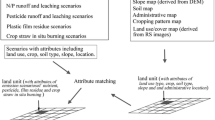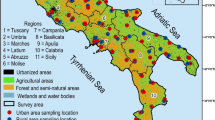Abstract
Background, aim, and scope
Endosulfan is one of the organochlorine pesticides (OCPs) and also a candidate to be included in a group of new persistent organic pollutants (UNEP 2007). The first national endosulfan usage inventories in China with 1/4° longitude by 1/6° latitude resolution has been reported in an accompanying paper. In the second part of the paper, we compiled the gridded historical emissions and soil residues of endosulfan in China from the usage inventories. Based on the residue/emission data, gridded concentrations of endosulfan in Chinese soil and air have been calculated. These inventories will provide valuable data for the further study of endosulfan.
Methods
Emission and residue of endosulfan were calculated from endosulfan usage by using a simplified gridded pesticide emission and residue model—SGPERM, which is an integrated modeling system combining mathematical model, database management system, and geographic information system. By using the emission and residue inventories, annual air and soil concentrations of endosulfan in each cell were determined.
Results and discussion
Historical gridded emission and residue inventories of α- and β-endosulfan in agricultural soil in China with 1/4° longitude by 1/6° latitude resolution have been created. Total emissions were around 10,800 t, with α-endosulfan at 7,400 t and β-endosulfan at 3,400 t from 1994 to 2004. The highest residues were 140 t for α-endosulfan and 390 t for β-endosulfan, and the lowest residues were 0.7 t for α-endosulfan and 170 t for β-endosulfan in 2004 in Chinese agricultural soil where endosulfan was applied. Based on the emission and residue inventories, concentrations of α- and β-endosulfan in Chinese air and agricultural surface soil were also calculated for each grid cell. We have estimated annual averaged air concentrations and the annual minimum and maximum soil concentrations across China. The real concentrations will be different from season to season. Although our model does not consider the transport of the insecticide in the atmosphere, which could be very important in some areas during some special time, the estimated concentrations of endosulfan in Chinese air and soil derived from the endosulfan emission and residue inventories are in general consistent with the published monitoring data.
Conclusions
To our knowledge, this work is the first inventory of this kind for endosulfan published on a national scale. Concentrations of the chemical in Chinese air and agricultural surface soil were calculated for each grid cell. Results show that the estimated concentrations of endosulfan in Chinese air and soil agree reasonably well with the monitoring data in general.
Recommendations and perspectives
The gridded endosulfan emission/residue inventories and also the air and soil concentration inventories created in this study will be updated upon availability of new information, including usage and monitoring data. The establishment of these inventories for the OCP is important for both scientific communities and policy makers.






Similar content being viewed by others
References
El Beit IOD, Wheelock JV, Cotton DE (1981) Pesticide-microbial interaction in the soil. Int J Environ Stud 16:171–179
Chandler GT, Scott GI (1991) Effects of sediment-bound endosulfan on survival, reproduction and larval settlement of meiobenthic polychaetes and copepods. Environ Toxicol Chem 10:375
Gao HJ, Jiang X, Wang F, Bian YR, Wang DZ, Dend JC, Yan DY (2005) Residual levels and new inputs of chlorinated POPs in agricultural soils from Taihu Lake region. Pedosphere 15:301–309
Ghadiri H, Rose CW (2001) Degradation of endosulfan in a clay soil from cotton farms of western Queensland. J Environ Manage 62:155–169
Gildemeister H, Jordan HJ (1984) Aerobic Soil Metabolism Study of the Insecticide Hoe 002671 (Endosulfan). Hoechest Aktiengesellschaft, Germany. Document No. A29680 dated November 1984. Unpublished report (quoted by NRA 1998)
Goebel H, Gorbach S, Knauf W, Rimpau RH, Huttenbach H (1982) Properties, effects, residues and analytics of the insecticide endosulfan. Residue Rev 83:1–174
Gregor DJ, Gummer WD (1989) Evidence of atmospheric transport and deposition of organochlorine pesticides and polychlorinated biphenyls in Canadian Arctic snow. Environ Sci Technol 23:561–565
Halsall CJ, Bailey R, Stern GA, Barrie LA, Fellin P, Muir DCG, Rosenberg B, Rovinski FY, Kononov EY, Pastukhov B (1998) Multi-year observations of organohalogenated pesticides in the Arctic atmosphere. Environ Pollut 102:51–62
Hansen KM, Christensen JH, Brandt J, Frohn LM, Geels C, Skjoth CA, Li YF (2008) Modelling short-term variability of α-hexachlorocyclohexane in Northern Hemispheric air. J Geophys Res 113:D02310. doi:10.1029/2007JD008492
Harner T, Bidleman TF, Jantunen LMM, Mackay D (2001) Soil-air exchange models of persistent pesticides in the U.S. Cotton Belt. Environ Toxicol Chem 20:1612–1621
Howard H (1991) Handbook of environmental fate and exposure data for organic chemicals, pesticides. Lewis, Ann Arbor
Hung H, Halsall CJ, Blanchard P, Li HH, Fellin P, Stern G et al (2002) Temporal trends of organochlorine pesticides in the Canadian arctic atmosphere. Environ Sci Technol 36:826–868
Hung H, Halsall CJ, Blanchard P, Li HH, Fellin P, Stern G, Rosenberg B (2005) Temporal and spatial variabilities of atmospheric polychlorinated biphenyls (PCBs), organochlorine (OC) pesticides and polycyclic aromatic hydrocarbons (PAHs) in the Canadian arctic: results from a decade of monitoring. Sci Total Environ 342:119–144
Jayashree R, Vasudevan N (2007) Persistence and distribution of endosulfan under field condition. Environ Monit Assess 131:475–487
Jia H, Li YF, Wang D, Cai D, Yang M, Ma J, Hu J (2008) Endosulfan in China—1. Gridded usage inventories. Environ Sci Pollut Res . doi:10.1007/s11356-008-0042-z
Jiang WM, Wu XM (1990) A linked three-dimensional PBL and dispersion model in coastal regions. Boundary-Layer Meteorol 53:43–62
Kalnay E, Kanamitsu M, Kistler R, Collins W, Deaven D, Gandin L, Iredell M, Saha S, White G, Woollen J, Zhu Y, Leetmaa A, Reynolds B, Chellia M, Ebisuzaki W, Higgins W, Janowiak J, Mo KC, Ropelewski C, Wang J, Jenne R, Joseph D (1996) The NCEP/NCAR reanalysis project. Bull Am Meteorol Soc 77:437–471
Kennedy IR, Ahmad N, Tuite J, Kimber S, Sebastian S, Lee A (1994) Transport and fate of pesticides in cotton production systems, In Minimizing the Impact of Pesticides on the Riverine Environment Using the Cotton Industry as a Model. Second Annual Workshop, LWRRDC, Brisbane, Australia
Kennedy IR, Sanchez-Bayo F, Kimber SWL, Beasley H, Ahmad N (1998) Movement and fate of endosulfan on-farm (New South Wales), pp 33–37. In Minimizing the Impact of Pesticides on the Riverine Environment: Key Findings from Research with the Cotton Industry, LWRRDC Occasional Paper 23/98, Canberra, Australia
Koziol AS, Pudykiewicz JA (2001) Global-scale environmental transport of persistent organic pollutants. Chemosphere 45:1181–1200
Li J, Zhang G, Guo L, Xu W, Li X, Lee CSL, Ding A, Wang T (2007) Organochlorine pesticides in the atmosphere of Guangzhou and Hong Kong: regional sources and long-range atmospheric transport. Atmos Environ 41:3889–3903
Li YF, Bidleman TF (2003) Correlation between global emissions of α-hexachlorocyclohexane and its concentrations in the arctic air. J Environ Informatics 1:52–57
Li YF, MacDonald R (2005) Sources and pathways of selected organochlorine pesticides to the Arctic and the effect of pathway divergence on HCH trends in biota: a review. Sci Total Environ 342:87–106
Li YF, Bidleman TF, Barrie LA, McConnell LL (1998) Global hexachlorocyclohexane use trends and their impact on the arctic atmospheric environment. Geophys Res Lett 25:39–41
Li YF, Scholtz MT, van Heyst BJ (2000) Global gridded emission inventory of α-hexachlorocyclohexane. J Geophys Res 105:6621–6632
Li YF, Bidleman TF, Barrie LA (2001) Toxaphene in the United States: (2) Emissions and residues. J Geophys Res 106(D16):929–938
Li YF, Venkatesh S, Li D (2004) Modeling global emissions and residues of pesticides. Environ Model Assess 9:237–243
Louuie PKK, Sin DW (2003) A preliminary investigation of persistent organic pollutants in ambient air in Hong Kong. Chemosphere 52:1397–1403
Ma J, Daggupaty SM, Harner T, Li YF (2003) Impacts of lindane usage in the Canadian prairies to the Great Lakes ecosystem—Part 1: Coupled atmospheric transport model and modeled concentrations in air and soil. Environ Sci Technol 37:3774–3781
Ma J, Venkatesh S, Li YF, Daggupaty SM (2005a) Tracking toxaphene in the North American Great Lakes Basin—1. Impact of toxaphene residues in the U.S. soils. Environ Sci Technol 39:8123–8131
Ma J, Venkatesh S, Li YF, Daggupaty SM (2005b) Tracking toxaphene in the North American Great Lakes Basin—2. A strong episodic long-range transport event. Environ Sci Technol 39:8132–8141
Miles CJ, Pfeuffer RJ (1997) Pesticides in canals of South Florida. Arch Environ Contam Toxicol 32:337–345
NRA (1998) The NRA Review of Endosulfan, 2, NRA National Registration Authority for Agricultural and Veterinary Chemicals: Existing chemicals program Section 7 ACT Australia
NRC (1975) National Research Council Canada, Endosulfan: Its Effects on Environmental Quality Subcommittee on Pesticides and Related Compounds, NRC Associate Committee on Scientific Criteria for Environ Quality, Report No. 11, Ottawa, Canada. In: http://pmepccecornelledu/profiles/extoxnet/dienochlor-glyphosate/endosulfan-exthtml
Patton GW, Walla MD, Bidleman TF, Barrie LA (1991) Polycyclic aromatic and organochlorine compounds in the atmosphere of northern Ellesmere Island, Canada. J Geophys Res 96:10867–10877
Pesticide Electronic Handbook (2006) http://www.chinapesticide.gov.cn/
Peterson SM, Batley GE (1993) The fate of endosulfan in aquatic ecosystems. Environ Pollut 82:143
Pozo K, Harner T, Wania F, Muir DCG, Jones KC, Barrie LA (2006) Towards a global network for persistent organic pollutants in air: results from the GAPS study. Environ Sci Technol 40:4867–4873
Qiu X, Zhu T, Li J, Pan P, Li Q, Miao G, Gong J (2004) Organochlorine pesticides in the air around the Taihu Lake, China. Environ Sci Technol 38:1368–1374
Qiu X, Zhu T, Yao B, Hu J, Hu S (2005) Contribution of dicofol to the current DDT pollution in China. Environ Sci Technol 39:4385–4390
Qiu X, Zhu T, Wang F, Hu J (2008) Air–water gas exchange of organochlorine pesticides in Taihu Lake, China. Environ Sci Technol 42:1928–1933
Scholtz MT, McMillan AC, Li YF, Ting N, Taylor A, and Van Heyst BJ (1998) Global pesticide emissions: development of pesticide emission factors on a global 1°×1° longitude-latitude grid and global emissions of Hexachlorocyclohexane. Final Rep CGEIC-1998-2, pp 1–89, Can Global Interpretation Cent, Toronto, Ontario
Simonich SL, Hites RA (1995) Global distribution of persistent organochlorine compounds. Science 269:1851–1854
UNEP (2007) Proposal for listing Endosulfan in the Stockholm Convention on Persistent Organic Pollutants, Stockholm Convention on Persistent Organic Pollutants Persistent Organic Pollutants Review Committee, Third meeting, Geneva, 19–23 November
Walker WW, Cripe CR, Pritchard PH, Bourquin AW (1988) Biological and abiotic degradation of xenobiotic compounds in vitro estuarine water and sediment/water systems. Chemosphere 17:2255–2270
Wang F, Jiang X, Bian Y-R, Yao F-X, Gao H-J, Yu G-F, Munch JC, Schroll R (2007) Organochlorine pesticides in soils under different land usage in the Taihu Lake region, China. J Environ Sci 19:584–590
Wang F, Bian YR, Jiang X, Gao HJ, Yu GF, Deng JC (2006) Residual characteristics of organochlorine pesticides in Lou soils with different fertilization modes. Pedosphere 16:161–168
Xu HZ, Jia N, Ren R (2005) The usage and perniciousness of environmental hormone organochlorine pesticides. Environ Sci Manage 30(5):83–85 in Chinese
Zhang LS, Ma JM, Venkatesh S, Li YF, Cheung P (2008) Modeling evidence of episodic intercontinental long-range transport of lindane. Environ Sci Technol 42:8791–8797
Zhang Z, Hong H, Zhou JL (2002) Transport and fate of organochlorine pesticides in the River Wuchuan, southeast China. J Environ Monit 4:435–441
Acknowledgments
The authors wish to thank Dalian Maritime University for funding this research project. Valuable comments from Dr. Martin Scheringer at the Swiss Federal Institute of Technology are highly appreciated.
Author information
Authors and Affiliations
Corresponding author
Additional information
Responsible editor: Roland Weber
Rights and permissions
About this article
Cite this article
Jia, H., Sun, Y., Li, YF. et al. Endosulfan in China 2—emissions and residues. Environ Sci Pollut Res 16, 302–311 (2009). https://doi.org/10.1007/s11356-009-0125-5
Received:
Accepted:
Published:
Issue Date:
DOI: https://doi.org/10.1007/s11356-009-0125-5




